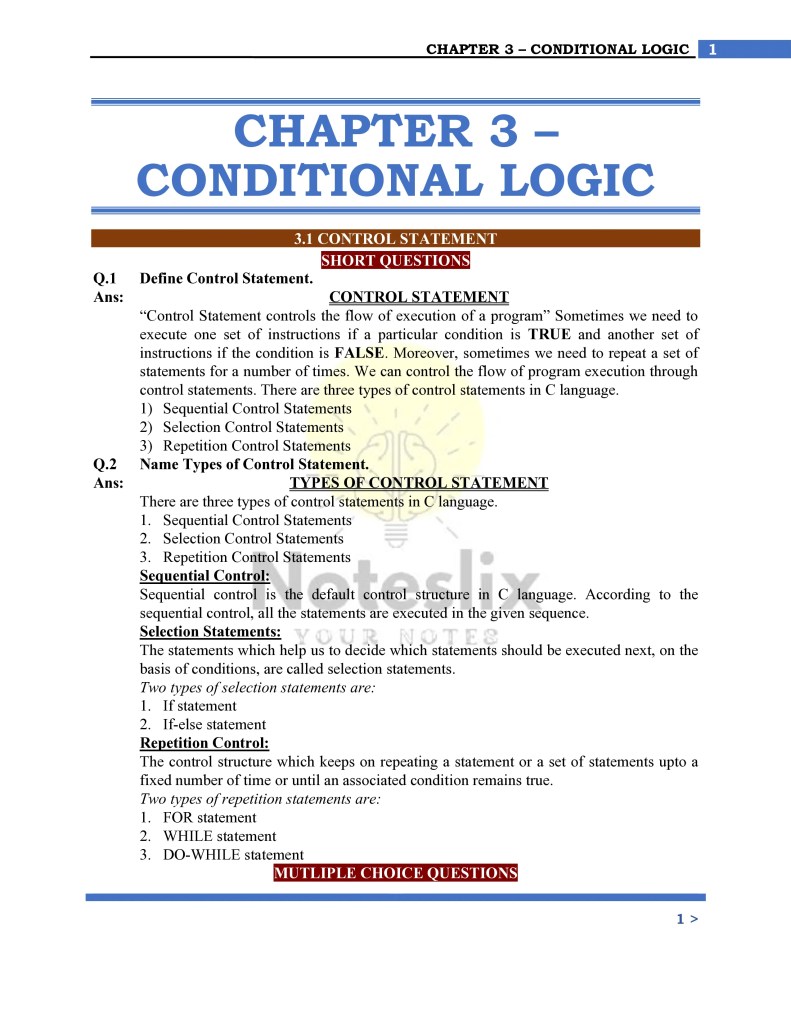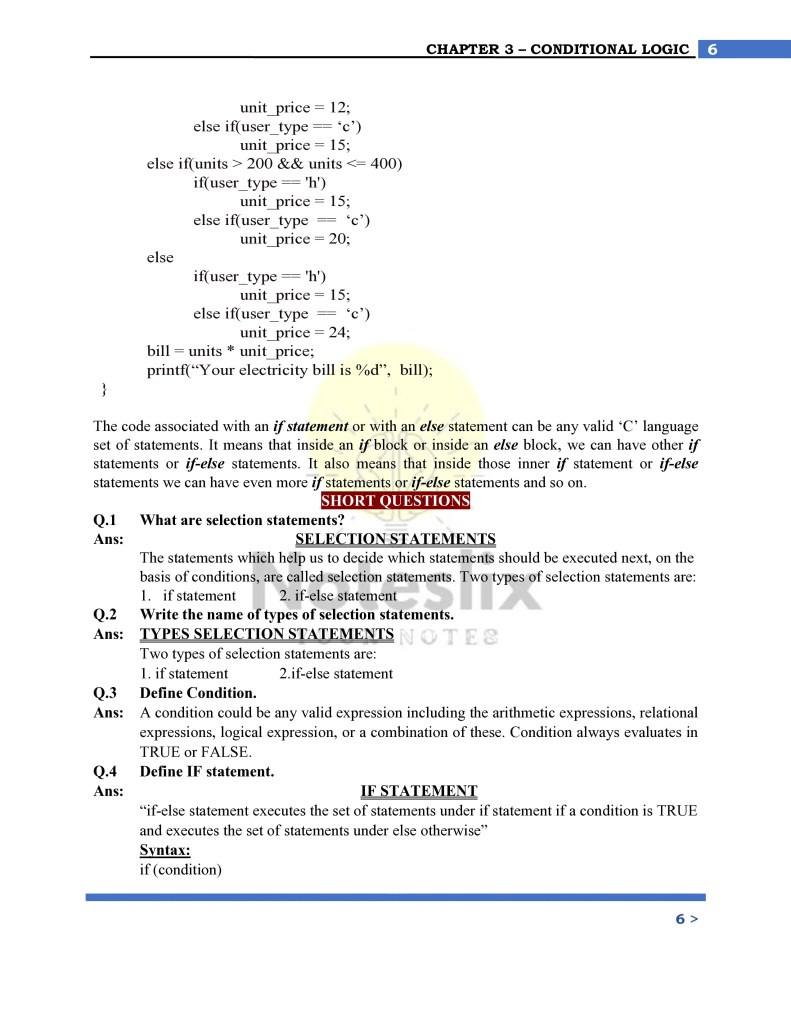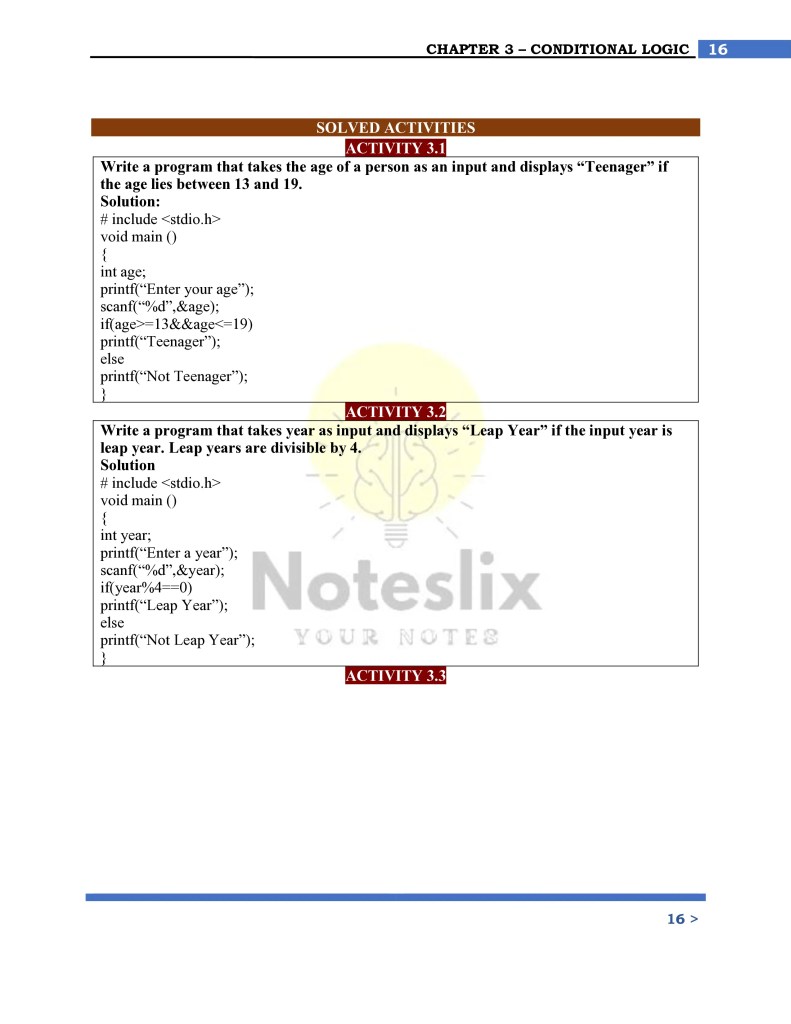Chapter 3 of the Class 10 Computer curriculum, titled Conditional Logic, focuses on the foundation of decision-making in programming. This chapter introduces students to control statements, their types, and practical implementations.
By mastering these concepts, students can develop logic-based programs efficiently. Our detailed, solved notes provide a systematic approach to grasping these crucial topics, making preparation for exams seamless and effective.



















Topics Covered in These Notes
The notes from Chapter 3 cover the following essential topics in detail:
- Control Statements: An introduction to control flow in programming.
- Types of Control Statements: Sequential, selection, and repetition statements.
- Selection Statements: Includes
if,if-else, and nested structures. - Flowchart Representations: Visual guides to understanding logic flow.
- Multiple Choice Questions (MCQs): Reinforcing knowledge with objective questions.
- Short and Long Questions: In-depth explanations and examples.
- Programming Activities: Practical C language programs for real-world applications.
These topics ensure comprehensive understanding, catering to theoretical and practical needs.
Class 10 Computer Chapter 3 Solved Notes Topic Wise
Our solved notes address the chapter’s concepts systematically:
- Control Statements
- Control statements guide the program’s flow, enabling conditional and repetitive execution.
- Sequential Control: The default structure, where instructions execute in order.
- Selection Control: Helps in decision-making using conditions.
- Repetition Control: Executes a block repeatedly until a condition changes.
- Selection Statements
ifStatements: Executes code when a specific condition is true. Example:cCopy codeif (marks > 50) { printf("Pass"); }if-elseStatements: Provides alternative execution paths based on conditions.- Nested Selection: Handles multiple layers of conditions for complex scenarios.
- Multiple Choice Questions
- Includes questions like identifying default control structures, condition formats, and logical operators. These MCQs strengthen theoretical understanding and prepare students for quick decision-making.
- Short and Long Questions
- Examples include definitions of control statements, selection statements, and conditions. The notes provide precise answers to commonly asked exam questions.
- Programming Activities
- Program 1: Checking a student’s grade based on their percentage.
- Program 2: Calculating electricity bills for home and commercial users.
- Program 3: Determining the largest of three numbers.
- Program 4: Calculating volumes of geometrical shapes (cube, cylinder, and sphere).
Tool for Success in Exams
These solved notes are designed to equip students with the knowledge and confidence needed to excel in exams. Key features include:
- Step-by-step solutions for programming problems to ensure clarity and understanding.
- Exam-focused content, highlighting frequently asked questions, important definitions, and coding syntax.
- Practical examples to enhance application-based learning, essential for both theoretical and practical exams.
By practicing these notes, students can significantly improve their problem-solving skills and logical thinking abilities.
Colored Notes
Our notes incorporate visually appealing formats with:
- Highlighted keywords to emphasize important terms.
- Color-coded sections for different topics like MCQs, short questions, long questions, and programming tasks.
- Clear diagrams and flowcharts for better understanding of complex concepts like selection and nested statements.
These visual aids make studying more engaging and effective, ensuring better retention of information.
Notes Are Free to Use
One of the standout features of these notes is their free availability. Students, teachers, and anyone preparing for exams can access this valuable resource without any cost. Sharing these notes fosters collaborative learning and supports a broader community of learners.
Notes Are Mistake-Free
Accuracy is paramount in academic content. These notes are thoroughly reviewed and verified to ensure:
- Error-free definitions, syntax, and examples to prevent misconceptions.
- Validated programs with tested outputs to provide students with reliable solutions.
- Precise answers to questions commonly asked in exams, minimizing any chance of confusion.
This guarantees that students receive high-quality material to support their learning.
Conclusion
Chapter 3 of the Class 10 Computer syllabus lays the groundwork for understanding decision-making in programming. By studying our solved notes, students gain a comprehensive understanding of conditional logic, control statements, and their practical applications.
These notes, enhanced with visuals, programming examples, and precise answers, are an indispensable tool for mastering the subject. Whether it’s for exams or personal growth in programming, these notes will undoubtedly prove invaluable.
Other Class 10 Computer Solved Notes Topic Wise
- Class 10 Computer Chapter 1 Solved Notes Topic Wise
- Class 10 Computer Chapter 2 Solved Notes Topic Wise
- Class 10 Computer Chapter 4 Solved Notes Topic Wise
- Class 10 Computer Chapter 5 Solved Notes Topic Wise

